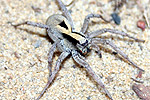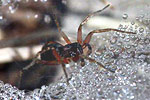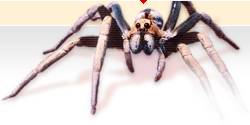
Wolf Spiders
Lycosidae Sundevall 1833
Identification
Wolf spiders share a number of characters, which clearly identify them as members of this family. The eyes are arranged in three rows. The front row has four small eyes, followed by two rows with two eyes each that are generally much larger. Females of wolf spiders display mobile brood care. They carry their eggsacs fixed to their spinnerets and subsequently the young on their abdomen.
 opens in new window
opens in new window
Perth, Western Australia
The smallest wolf spider currently known to science is Zoica minuta McKay, 1979 from Western Australia. Mature females of this species can be less than one millimetre long, their tiny eggsacs contain only 3-5 eggs. The largest wolf spiders can reach more than 30 mm body length. In Australia, common and fairly large species are ‘Lycosa’ leuckartii (Thorell, 1870) and ‘Lycosa’ godeffroyi L. Koch, 1865, the common Garden Wolf Spider.
Biology
Wolf spiders inhabit nearly every habitat, and specialists can be found from see shores up to top of alpine mountains. They belong to the most common spiders, in particular in open and undisturbed areas and near water. In Australia, wolf spiders of the genus Tetralycosa have managed to establish themselves on the surface of saltlakes. Wolf spiders are ground living spiders that generally do not build a web.
 opens in new window
opens in new window
Venonia micarioides
from Brisbane, Queensland
Only a few forms (e.g. genera Venonia (see picture), Sosippus) are known to build sheet webs with a funnel into which the spider retreats. In addition to these sheet web builders, wolf spiders are known to display a variety of foraging strategies. Smaller species (e.g. in the genera Pardosa, Artoria) are generally vagrant and active during the day. Even females do not build a retreat when they care for their brood. In other groups (e.g. Alopecosa, Trochosa), females will dig out a retreat in which they stay until the young hatch. Larger species (e.g. Lycosa, Dingosa, Geolycosa) built permanent burrows that the spiders only leave at night to forage. Some stay at the entrance of the burrow and wait for prey to pass by. Some wolf spiders close their burrow with a trapdoor (e.g. Lycosa forresti McKay 1973 from Western Australia), other built a palisade-like turret around the entrance (e.g. the Australian Mainosa longipes (L. Koch, 1878) and Dingosa serrata (L. Koch, 1877).
Wolf spiders in Australasia
The taxonomy and systematic of wolf spiders in Australasia is still in its infancy. A comprehensive and recent revision is only available for New Zealand. A limited number of genera have been revised from Australia, but the South East Asian fauna is virtually unknown. Most species have not been treated since their original description in the late 19th century.
Australia
There are currently ca. 150 species of wolf spiders in 4 subfamilies (Zoicinae, Venoniinae, Artoriinae and Lycosinae) and ca. 25 genera known from Australia. The Zoicinae include only one genus, Zoica, with about three species from tropical northern Australia. The Venoniinae include the genera Anomalosa (2 species), Venonia (7 species) and Allotrochosina (2 species), all of which have received recent taxonomic attention. The Artoriinae have only recently been established and include for example the speciose genus Artoria (20 described species and many more undescribed), Artoriopsis (7 described species), Tetralycosa (4 species, another 9 undescribed), and Diahogna (4 species). In contrast, the generic placement of many species within the subfamily Lycosinae does not in any way reflect their phylogenetic history. Some genera have been recently revised, such as Venatrix (26 species), Tuberculosa (4 species), Mainosa and Knoelle (both monotypic), and Dingosa (4 species). However, many species, for example the common Garden Wolf Spider, are currently placed in the wrong genus. The family is currently under revision by Volker Framenau at the Western Australian Museum (funded by ABRS) and therefore the taxonomy is in a constant flux. For updates, check Volker’s webpage on ‘The wolf spiders of Australia’
New Zealand
The wolf spiders of New Zealand were recently revised by Cor Vink`s (2002) `Fauna of New Zealand 44`. This revision also includes a key to the New Zealand wolf spiders. New Zealand has 27 species of wolf spiders in 6 genera. The genus Anoteropsis dominates the country with 20 species alone. Other genera with representatives in New Zealand include Artoria (3 species) and Allotrochosina, Hogna, Notocosa and Venatrix with 1 species each.
South East Asia
There is currently no comprehensive treatment on the wolf spiders of South East Asia, but information of some species can be found in Murphy & Murphy (2000) ‘An Introduction to the spiders of South East Asia’, Malaysian Nature Society (United Sengalor Press Sdn. Bhd.).

